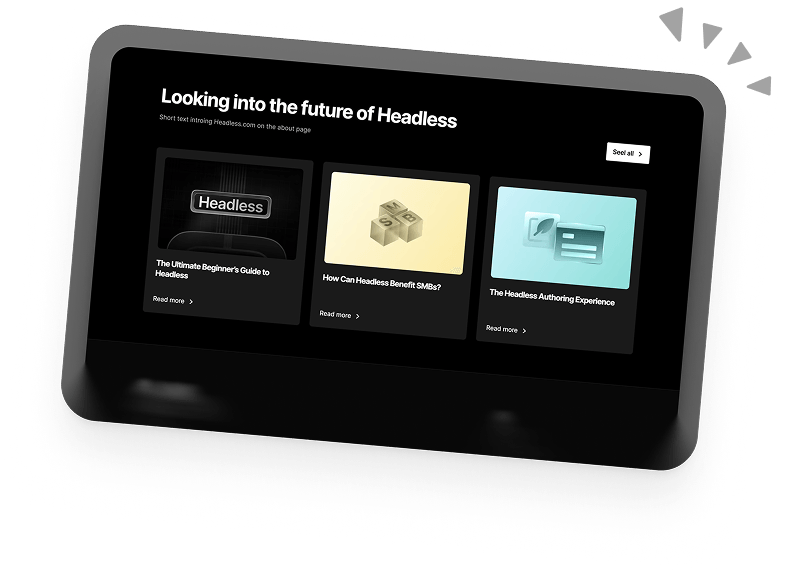Should You Use Headless WordPress? (Pros and Cons)
If you’ve been on the hunt for ways to improve your site, you’ve probably heard about Headless WordPress somewhere on the grapevine. Like most people, you’ll likely be enticed by the thought of a website that runs faster, has the flexibility to look and feel exactly how you want it to, and lets you easily manage content in one place.
Headless WordPress offers a tonne of benefits over traditional WordPress and, indeed, many other CMSs, but it’s essential to weigh up the pros and cons before choosing a CMS.
Headless WordPress excels in certain areas, but it can still be detrimental to your site if it’s poorly suited or improperly implemented.
To help you decide whether Headless WordPress is the right choice for you, we’ve compiled a list of the main advantages and disadvantages that come with this CMS.
Advantages of Headless WordPress
Let’s start with the good stuff: the reasons so many people are raving about Headless WordPress.
Content Flexibility
The central feature of Headless WordPress is its lack of a defined presentation layer (or “head”), allowing you to send content to any device or platform you want. You can post to a website, mobile app, smartwatch, and social media platforms, all from the comfort of your WordPress dashboard.
This flexible content delivery can be a huge advantage for enterprise companies with an extended online presence. And with the expansion of the IoT (internet of things) space, a Headless CMS allows you to adapt to any device.
You get to keep the good parts of WordPress (and leave the rest behind)
One of the critical benefits of Headless WordPress, as opposed to other Headless CMSs, is that it’s WordPress. Almost everyone knows how to use it. Chances are, your site is already running on WordPress.
Switching WordPress to Headless lets you keep the WordPress admin dashboard for managing and uploading content. This saves your team the time and effort of learning a whole new system.
WordPress is loved by content creators for its intuitive authoring experience, whereas developers often find it frustrating and restrictive. Headless WordPress lets both content creators and developers work with their preferred tools.
Scalability
Headless WordPress gives businesses room to grow and scale. Since the front and back-ends are decoupled, they can be scaled and updated separately. Furthermore, as you’re not stuck with a particular front-end framework, moving content to different setups (such as new tech-stacks or applications) is much easier.
Better User Experiences
Headless WordPress can bypass a lot of the technical limitations of the native WordPress platform. With the proper front-end framework, a Headless site runs significantly faster than monolithic WordPress.
Since site speed is a significant factor in user experience as well as Google’s SEO rankings, you can gain a serious competitive advantage with the right Headless tech-stack.
Enhanced Security
Separating the front and back-end reduces the extent to which people can exploit vulnerabilities. Even if a hacker compromises your front-end, your back-end is still safe. Furthermore, if someone manages to take down your site, you can still access all the content and quickly deploy it to another copy of the front-end.
Disadvantages of Headless WordPress
If you thought that Headless WordPress sounds a little too good to be true, then you were right. Unfortunately, there’s no such thing as a perfect solution, and, for all the good stuff, there are drawbacks to keep in mind.
Complexity
Unlike regular WordPress, you can’t get a Headless WordPress site up and running without knowing how to code. You’ll have to develop a front-end framework from scratch and configure an API to communicate with the back-end.
You also won’t be able to use plugins anymore. For functions that previously relied on plugins, you’ll need to develop them from scratch.
Lack Of Preview Features
A big drawback of Headless WordPress is that you lose the ability to preview a post before publishing it. This can be jarring to get used to for content creators who press “Preview” only to be met with a wall of JSON data. It also means you won’t be able to spot some formatting errors until a post has gone live.
It’s Resource-intensive
Headless is a big undertaking. It takes time and effort to do it right. A lot of components must be built from scratch, which means hiring developers who have to work with at least two codebases.
Overall, the deployment and maintenance of a Headless WordPress website lean heavily on development resources. This can end up being more expensive than other, simpler options.
For a lot of websites, it’s not the right choice.
Headless WordPress isn’t something that you should do just because you can. While Headless addresses many issues facing online businesses, it isn’t the perfect solution for everyone.
If you’re an enterprise company that needs extra security, competitive site speeds, and multi-channel content management, then Headless WordPress is probably the answer. For many other website owners, the amount of features you get with Headless isn’t necessary or worth the effort and expenditure.
Weighing up your options
Choosing a suitable CMS for your project is an important decision, and you need to consider how well a system fits with your goals and objectives. A Headless WordPress CMS offers significant advantages for enterprise-level businesses and large websites, but for smaller sites, it might be better to stick with a less resource-intensive option.
Book a 30-min Introduction Call
Let's jump on a quick intro call We'll break down your project, and pinpoint exactly how we can help.



Our clients  Holaa! love working with us see their stories below!
Holaa! love working with us see their stories below!






